Just a short distance from the inter-Korean border, Sokcho is a port city with
Mt. Seorak behind and the East Sea in front. It used to be part of North Korea,
lying north of the 38th parallel that divided Korea at the end of the Second World War.
But when the Korean War ended in a ceasefire in 1953, the military demarcation line was pushed up northward, placing the region south of the border.
North Korean refugees who had escaped south during the war formed
a small community by the sea and settled there.
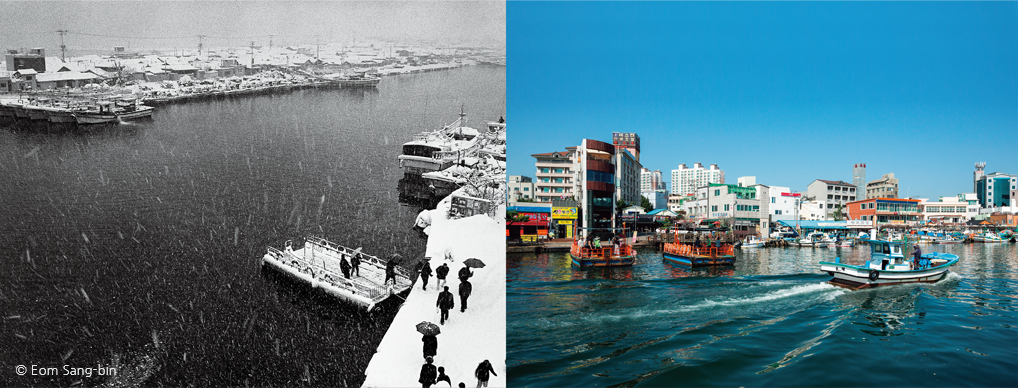
North Korean refugees who fled south during the Korean War made a village along the seaside of Sokcho their temporary home. Decades have since passed bringing changes to the living conditions, means of transportation and livelihood of the village.
One evening in early September, I met with Kim Eui-jun, chairman of the Sinpo Town Council, Sokcho District, at Sindashin restaurant, known for its authentic Hamgyong regional cuisine. He looked unbelievably young for his age and full of vigor. Whenever he talked about his northern homeland, his face flushed.
“I was just five at the time, so I only have vague memories. But that particular day, I remember clearly,” said Kim, recalling the Korean War. He fled to the South with his father, sister and six brothers. It was January 1952, a year after the Hungnam Evacuation. His family was on one of the three boats that departed from Sinpo and sailed through the waters off the coast of Mayang Island. There were around 80 people on each boat, making the total close to 250. Unfortunately, one boat was bombed by the North Korean People’s Army and sunk. His voice quivered as he struggled to finish the sentence.
“Those on that boat wouldn’t have made it in the freezing cold. The rest of us went as far south as Busan, then came up here to Abai Village, believing we would soon be able to return home to the North. But it’s already been 65 years,” he said sadly.
Abai is a word in the Hamgyong dialect that means “father” or “elderly man.” The village earned this nickname because of the many North Korean refugees who had led a rough life as fishermen in the North before settling and establishing a community here.
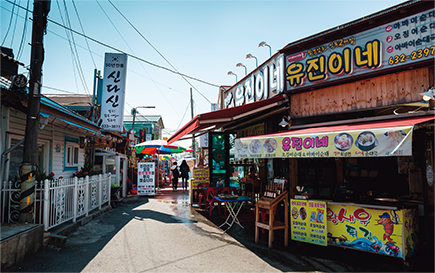
When the local food of Hamgyong Province became known nationwide, more and more restaurants specializing in the cuisine popped up, and soon people from all over the country began crowding the village to taste the traditional dishes.
Home Address Etched in the Heart
Kim grew up in a relatively well-to-do family; his grandfather owned a fish canning factory in Sinpo-eup, Bukchong County, South Hamgyong Province. When the North Korean authorities began to purge the bourgeoisie, Kim’s family was forced to escape to the South.
His father gave him a hand-drawn map just before he passed away. Kim pulled out a faded piece of paper from his wallet. It was a detailed drawing of his neighborhood in the North. To the right of the fisheries federation, opposite Harbor Inn in Sinpo’s 2nd District, the words “our house” were clearly marked. The People’s Army headquarters was located across the main road in Sinpo’s 3rd District. Written neatly and carefully in Chinese characters on one side of the paper is: “No. 727, Sinpo 2nd District, Bukchong County, South Hamgyong Province, Tel. 331.” The address and telephone number probably don’t exist anymore, but Kim still carries the map on him at all times.
He says the first thing he is going to do when the two Koreas are unified is use the map to find his childhood home.
Sokcho, part of Yangyang County in Gangwon Province, was promoted to a town (eup) in 1942. The total population at that time was only around 4,000 to 5,000. In the winter of 1950, the refugees who had fled far south on the Korean peninsula during the Hungnam Evacuation came up northward again and made Sokcho their temporary home. Refugees from the Hamgyong provinces and the Goseong and Tongcheon counties in northern Gangwon Province who escaped south by land before the truce line was drawn also flocked here. After the intense battles between the North and South ended in a ceasefire, the military demarcation line was established just north of Sokcho, making it part of South Korean territory. Sokcho had a thriving fishing industry, and the many refugees who had fled here, mostly from South Hamgyong Province, ended up settling in the village permanently.
At first, they built makeshift underground shacks on land where the U.S. military was stationed. Some dug the ground up to their waists and built temporary dwellings with just a roof to shelter them from the rain. They thought they would be able to return home in two or three months. Soon, a community of 2,000 households was formed. Those were difficult times, when the men had to go out to sea on small fishing boats and women had to sit on the cold ground and remove the fish from the nets.
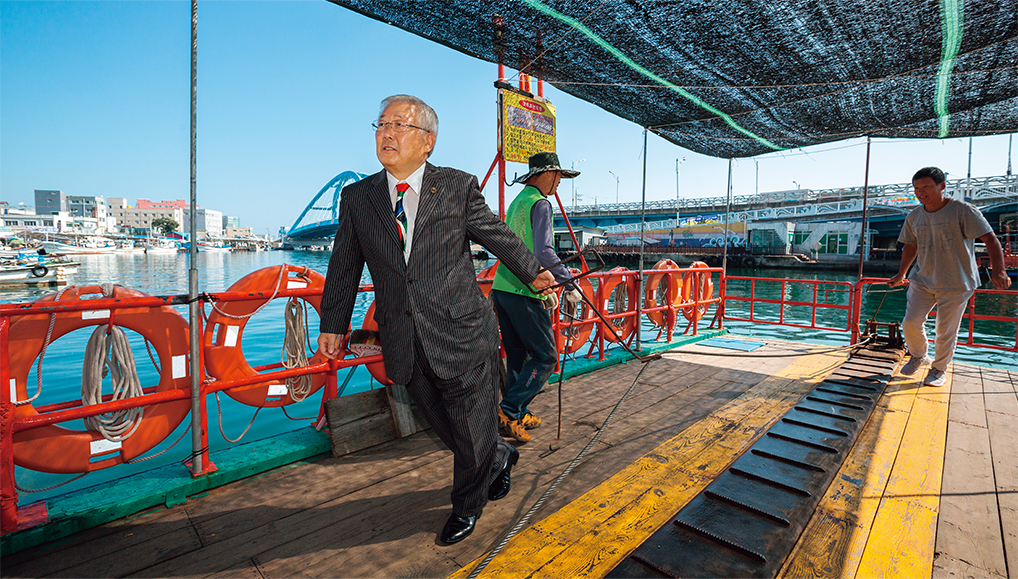
Kim Eui-jun, originally from Sinpo-eup, Bukchong County, South Hamgyong Province, pulls the shuttle boat called gaetbae. The boat used to be the sole means of transportation for the villagers to reach downtown Sokcho, but now two bridges connect their village with the mainland. Still, the boat remains a popular attraction among tourists.
Location of Popular TV Drama
Abai Village was built on a sandbar on Lake Cheongcho, which connects to the East Sea. Change came to this village when a harbor was built by dredging, creating a waterway. That’s when the shuttle boat called gaetbae first appeared. The boat was a lifeline for the people of Abai Village, a means of getting to the central market in downtown Sokcho to sell straw ropes or paper bags they had made to earn some money.
Gradually, word began to spread about the native Hamgyong cuisine that the villagers enjoyed — specialties such as abai sundae (Korean sausage) or the spicy cold naengmyeon (buckwheat noodles) with raw sole or raw pollack that were eaten on special occasions. The village became known nationwide after the TV drama series “Autumn in My Heart,” which was filmed here, became a major hit. Restaurants selling local specialties of Hamgyong began popping up all over the village.
Abai sundae, a sausage made of steamed pork intestines stuffed with dried radish greens, minced pork, pork blood, garlic and soybean paste, captivated the taste buds of city folks. In the old days, when the pollack catch off the coast of Sokcho was plentiful, fish would be used as casing for the stuffing instead of pig’s intestines. But pollack has now virtually disappeared from the nearby coastal waters. The local food of Hamgyong is sweet and salty. It appeals to young visitors from the city who love strong flavors. Sweet and salty is a perfect match for the thrill and excitement of travel. It doesn’t matter which seas the squid or pollack are from; they are sure to delight the palate.
Two bridges now connect Abai Village to the mainland. Seorak Bridge and Geumgang Bridge crossing over the village provide spectacular views at night. But the shuttle boat is still a popular means of transport, especially among tourists. The large flat boat is akin to a raft and passengers need to pull the steel cable to cross the waterway. But for tourists, rather than being an inconvenience this is a fun experience. That notwithstanding, the boat is expected to be replaced by a larger, more convenient vessel to accommodate the rise in tourism. And that’s not the only change in the village. Surprisingly, dakgangjeong (sweet and spicy crispy fried chicken) has recently become all the rage at Sokcho’s central market. Food stalls selling the crispy chicken that has a stronger, spicier taste than abai sundae line the streets at night, and it looks like the fried chicken dish may soon become the leading favorite.
Previously a part of Sokcho’s 4th District, Abai Village’s official administrative name now is Cheongho-dong. The number of households has dipped to around 240. Only around 60 or so first-generation North Korean refugees remain alive, and their second- and third-generation offspring have put down roots here, making Sokcho their second home. Around 8,000 people, or one-tenth of Sokcho’s population, are of Hamgyong ancestry.
The theme of the “Cultural Festival of Displaced People,” held every spring, arouses poignant emotions: “Memories of spring in my hometown that even time cannot erase.”
Nostalgia for their northern hometown floods their hearts, especially during the traditional holidays, but they have learned to dismiss these feelings. Perhaps it is because they have been forced to abandon all hope of ever returning home.
Nostalgia for their northern hometown floods their hearts,
especially during the traditional holidays, but they have learned to
dismiss these feelings. Perhaps it is because they have been
forced to abandon all hope of ever returning home.
Memories, Dreams and Hopes
My Korean language teacher in high school was the famous poet Hwang Geum-chan (1918–2017), a native of Sokcho known as the “east coast poet.” He was a teacher who tried to instill humanistic sensibilities in his students rather than just teach from the textbook. From time to time, he told us stories about his hometown. After studying in Tokyo prior to national liberation, he had lived for a while in Songjin, North Hamgyong Province, and the stories he told of the sea, with a hint of Hamgyong dialect, sounded like poetry to my young ears. In our classical literature class, we learned about the “Song of Gangwon Scenes” (Gwandong byeolgok), written by Jeong Cheol in 1580, which praised the beautiful scenery of Chongseok Pavilion in Tongcheon County and Cheonggan Pavilion and Lake Samilpo in Goseong County. This further piqued my interest. But at that time, Sokcho and Mt. Seorak seemed out of my reach, places far beyond the steep Taebaek Mountain Range.
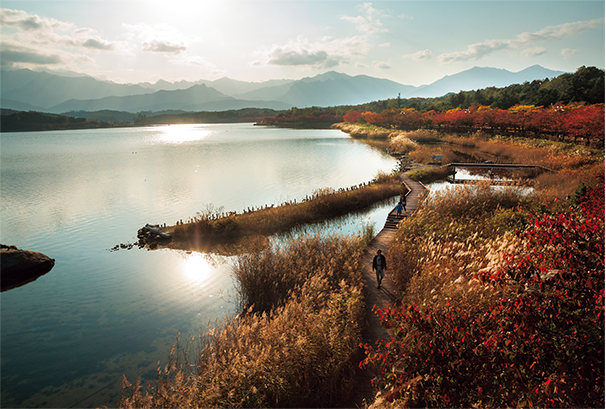
Lake Yeongnang, located in northwestern Sokcho, is a popular tourist spot known for its beautiful scenery through all seasons. Its name originates from the story of the four young warriors of Silla, including Yeongnang, who were enraptured by the scenery while training for a martial arts contest.
One spring day in the early 1970s, just after our college midterm exams, I hopped on a bus bound for Sokcho that departed from Dongmajang Bus Terminal at around noon with a friend born and bred in the city. The bus meandered along Hangyeryeong Pass, and when we finally arrived at Sokcho Terminal, the sun was already setting over Misiryeong Pass. The trip had taken half a day and we were exhausted. Dusk was falling and the lights were coming on at the lighthouse on the Yeonggeumjeong boulder. But we took another bus bound for Ganseong. When we arrived at Gyoam-ri, darkness had already settled over the beach and port. All I could hear was the sound of the wind blowing in from the sea through the pine trees on the cliff.
As the only sea I had seen up until then was in Incheon, the image of the sea etched in my mind was a dark brown color mixed with a tangy smell, and at times, a glittering blue when the sun hit the water. In fact, we had learned that the West Sea was called the Yellow Sea. It was the monotone age, when television was black and white, as were our school uniforms. Maybe that was why early next morning, when I gazed out at the sea in all shades of blue, seen between a tall pine tree and the roof of Cheonhakjeong, the “Pavilion of a Thousand Cranes,” standing on a steep cliff, I was overwhelmed with emotion. It was nothing like the dull “blue” I had learned of in art class. I wondered about the color of the waters beyond the East Sea — the South Pacific Ocean, the Atlantic or the Mediterranean. My imagination went wild and I was already dreaming of crossing these waters.
The way back to Seoul was a succession of modern literary landscapes. Buses to Seoul only ran two or three times a day. Our bus bumped along the new gravel road to Ganseong, covered in clouds of dust stirred up by the car in front. To the right, the sandy beach stretched endlessly. The beach from Mt. Seorak to Mt. Kumgang was rather plain, allowing us a brief break from the breathtakingly beautiful scenery. Crossing over Jinburyeong Pass, it took a full day to get to Seoul. My butt was sore from the long bumpy ride, and there was an acrid smell in my nose. Prior to the Korean War, Sokcho and Goseong County were North Korean territory, lying north of the 38th parallel, the original border between North and South Korea that was drawn shortly after the nation’s liberation from Japanese rule in 1945. After the war, the military demarcation line was pushed further northward to Yangyang County. The refugees from North Korea made Sokcho their home, with the grief and pain of separation entrenched in their hearts. Before a highway was built by tunneling through several places in the Baekdu Daegan mountain range, Sokcho was an out-of-the-way place that one had to take great pains to reach.
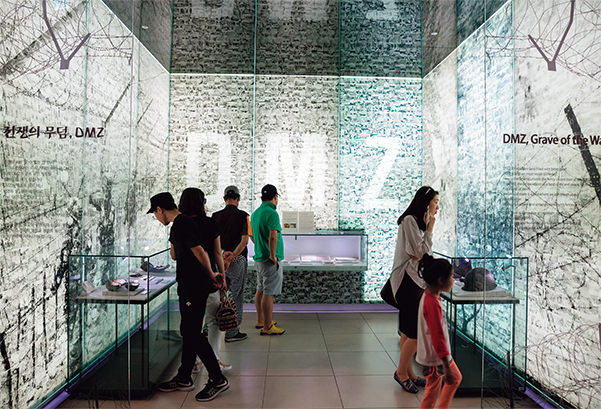
The DMZ Museum in Goseong, located just south of the DMZ at the northernmost tip of the east coast, has a permanent exhibition on the themes of peace and ecology.
I bought my first car in my mid-30s. When the seasons changed, I would drive along national road No. 7, which stretched along the east coast all the way to the Goseong Unification Observatory. I wanted to show my children, who were in elementary school, the site of the tragedy of a divided nation, but it was unthinkable back then. The DMZ was a potential flashpoint permeated by tension. A considerable period of time had passed before the general public was allowed to catch the view of Outer Kumgang and Lake Samilpo on the northern side from the observatory. We had to be satisfied with visiting Myeongpa-ri, the northernmost village on the east coast closest to the border, eat buckwheat noodles and potato pancakes, and then drive southward to Geojin, passing by Daejin.
Nonetheless, Hwajinpo was a great place for my children to experience firsthand the pain and sorrow of our nation’s division.
It also made for a great field trip, Hwajinpo being a good example of a lagoon formed as the sandbar built by ocean currents separated the water from the sea. The summer houses that once belonged to Syngman Rhee and Kim Il-sung, the founding presidents of the two Koreas, are located a short distance away from each other. The region was part of North Korean territory that was recovered after the Korean War; hence, the place has been ridden with extreme tension for decades. The summer recreation center of a women’s university was located in the area, giving the young soldiers a little something to be excited about amid the tense atmosphere. Hwajinpo was a place of contradiction, a mix of two extremes.
Breathtaking Scenery Made More Accessible
Sokcho became easier to reach when the tunnel was dug under the steep, meandering old road of Misiryeong Pass, from where it had been difficult to appreciate the magnificent views of Ulsan Rock. Visiting Mt. Seorak in middle age, I found that the valleys and peaks filled my heart with familiar warmth. When I visited Hwaam Temple at the foot of Misiryeong Pass, a sign that read “Hwaam Temple of Mount Kumgang” caught me by surprise. Why Mt. Kumgang and not Mt. Seorak? The temple was right by Misiryeong Pass. This just seemed to prove that Kumgang and Seorak are part of the same mountain range.
They share the same legend, too. Lake Yeongnang, which I have been frequenting recently, is connected with Lake Samilpo in Outer Kumgang by the same legend. After training in Mt. Kumgang, four members of hwarang, the elite warrior youths of Silla, who were known as the “four immortals” descended the mountain to participate in a martial arts contest in the capital, Seorabeol (present-day Gyeongju). On their way down, one of them, Yeongnang, saw the reflection of Ulsan Rock on the still waters of the lake. He became so enraptured by the sight that he completely forgot about the contest and stayed there to admire its beauty. Legend has it that the lake was therefore named after him. Likewise, the name Samilpo originated in the story of the four immortals being so captivated by the scenic beauty of the lake that they stayed there for three days (sam-il).
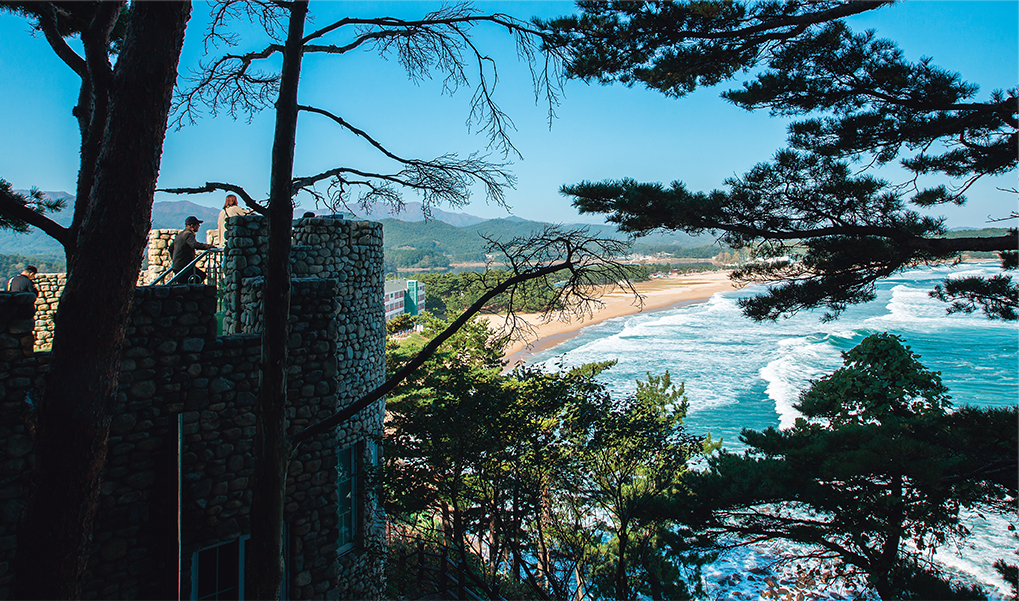
This two-story house at Hwajinpo Beach is called the “Kim Il-sung’s Villa” because it used to be the summer house of the former leader of North Korea and his family. Also known as the “Castle of Hwajinpo,” the house was damaged during the Korean War and has since been rebuilt as an exhibition hall for objects related to North Korea and the Kim family.
Walking around Lake Yeongnang, 7.8 kilometers in circumference, can be a delightful experience all year round. Spring offers a quiet walk alone on the trail where cherry blossoms are in full bloom; early summer is the time to stroll with someone special to Beombawi, or “Tiger Rock,” under the lush green zelkova trees. Then, at sunset, you will surely be enchanted by the picturesque silhouette of Ulsan Rock reflected on the lake, just like Yeongnang a thousand years ago. It could be said that Ulsan Rock is the origin of the name Sokcho, since its meaning stems from the wish to “tie (sok) a rope around the rock” and take it with you.
Lake Cheongcho, on the other hand, has a completely different atmosphere. Surrounded by the downtown area with many cars, people and bright neon signs, it is vibrant and lively well into the night. Those craving some hustle and bustle and all kinds of food can wander around the lakeside area. A one-hour yacht tour departs from Komarine Yacht Park and does a loop around Jo Island. The magnificent scenery of the Seorak mountain ridge lying beyond Lake Cheongcho and Expo Tower makes for amazing pictures, while the gorgeous view of Daecheongbong, the highest peak of Mt. Seorak, that looms over Seorak Bridge in Abai Village, will provide poetic inspiration. Snow-covered Mt. Seorak on a cold winter day set against a cloudless blue sky is another view simply breathtaking in its beauty.